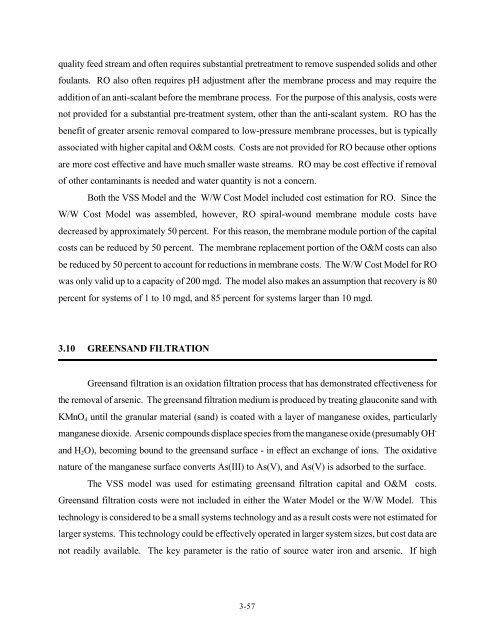Technologies and Costs for Removal of Arsenic From Drinking Water
Technologies and Costs for Removal of Arsenic From Drinking Water
Technologies and Costs for Removal of Arsenic From Drinking Water
You also want an ePaper? Increase the reach of your titles
YUMPU automatically turns print PDFs into web optimized ePapers that Google loves.
quality feed stream <strong>and</strong> <strong>of</strong>ten requires substantial pretreatment to remove suspended solids <strong>and</strong> otherfoulants. RO also <strong>of</strong>ten requires pH adjustment after the membrane process <strong>and</strong> may require theaddition <strong>of</strong> an anti-scalant be<strong>for</strong>e the membrane process. For the purpose <strong>of</strong> this analysis, costs werenot provided <strong>for</strong> a substantial pre-treatment system, other than the anti-scalant system. RO has thebenefit <strong>of</strong> greater arsenic removal compared to low-pressure membrane processes, but is typicallyassociated with higher capital <strong>and</strong> O&M costs. <strong>Costs</strong> are not provided <strong>for</strong> RO because other optionsare more cost effective <strong>and</strong> have much smaller waste streams. RO may be cost effective if removal<strong>of</strong> other contaminants is needed <strong>and</strong> water quantity is not a concern.Both the VSS Model <strong>and</strong> the W/W Cost Model included cost estimation <strong>for</strong> RO. Since theW/W Cost Model was assembled, however, RO spiral-wound membrane module costs havedecreased by approximately 50 percent. For this reason, the membrane module portion <strong>of</strong> the capitalcosts can be reduced by 50 percent. The membrane replacement portion <strong>of</strong> the O&M costs can alsobe reduced by 50 percent to account <strong>for</strong> reductions in membrane costs. The W/W Cost Model <strong>for</strong> ROwas only valid up to a capacity <strong>of</strong> 200 mgd. The model also makes an assumption that recovery is 80percent <strong>for</strong> systems <strong>of</strong> 1 to 10 mgd, <strong>and</strong> 85 percent <strong>for</strong> systems larger than 10 mgd.3.10 GREENSAND FILTRATIONGreens<strong>and</strong> filtration is an oxidation filtration process that has demonstrated effectiveness <strong>for</strong>the removal <strong>of</strong> arsenic. The greens<strong>and</strong> filtration medium is produced by treating glauconite s<strong>and</strong> withKMnO 4 until the granular material (s<strong>and</strong>) is coated with a layer <strong>of</strong> manganese oxides, particularlymanganese dioxide. <strong>Arsenic</strong> compounds displace species from the manganese oxide (presumably OH -<strong>and</strong> H 2 O), becoming bound to the greens<strong>and</strong> surface - in effect an exchange <strong>of</strong> ions. The oxidativenature <strong>of</strong> the manganese surface converts As(III) to As(V), <strong>and</strong> As(V) is adsorbed to the surface.The VSS model was used <strong>for</strong> estimating greens<strong>and</strong> filtration capital <strong>and</strong> O&M costs.Greens<strong>and</strong> filtration costs were not included in either the <strong>Water</strong> Model or the W/W Model. Thistechnology is considered to be a small systems technology <strong>and</strong> as a result costs were not estimated <strong>for</strong>larger systems. This technology could be effectively operated in larger system sizes, but cost data arenot readily available. The key parameter is the ratio <strong>of</strong> source water iron <strong>and</strong> arsenic. If high3-57
















